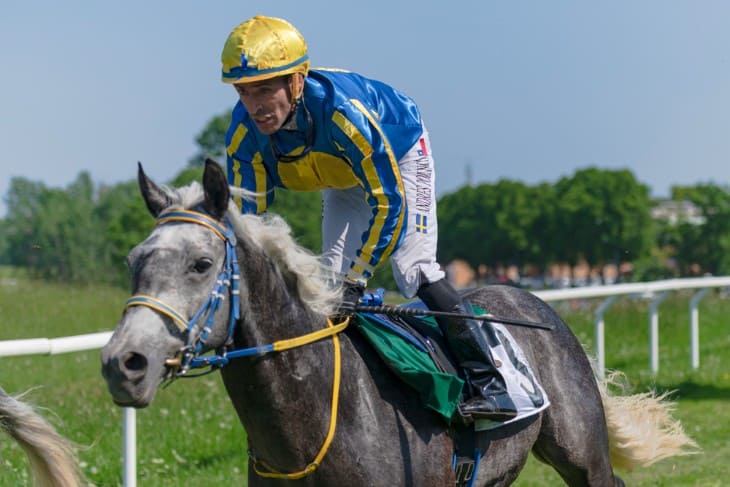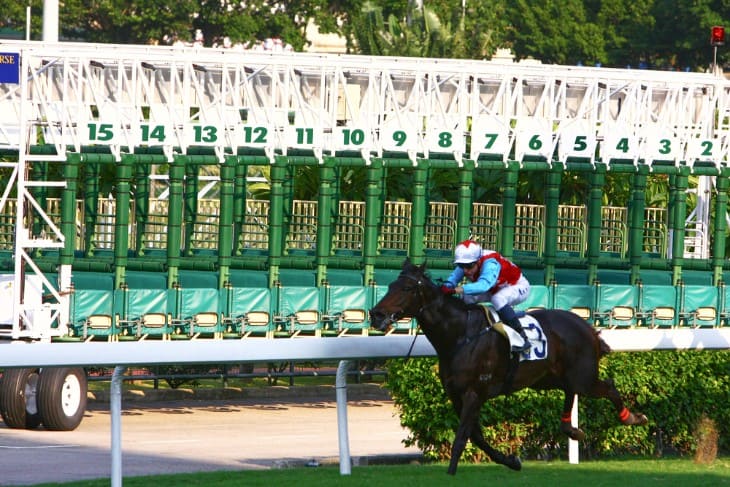Horse racing is not just a sport but also a passion. Among the most thrilling types of this game is hurdle racing, which combines flat racing speed with jumping challenges. This guide has been created to give newbies and seasoned enthusiasts a deeper comprehension of horse racing hurdles, starting with rules and race types and ending with betting strategies and tips for enjoying race day.
Introduction to Hurdle Racing
Hurdle races are fast-paced events that require speed combined with skill in an unusual way. In these races, horses sprint over a course strewn with hurdles they must jump over. Each hurdle is made from brushwood and stands at least three and a half feet above the ground. The races often stretch for two to three and a half miles.
This kind of horse racing is prevalent, especially in Britain and Ireland, where it originated many years ago. It tests how fast horses can run and their ability to negotiate obstacles while covering longer distances. Horses must be agile enough to clear jumps yet still have enough pace to compete along flat sections of the track.
Unlike flat races, jumps set hurdle races apart. This means riders need to work closely together with their mounts if they want any chance at winning them. A jockey has to know when precisely to steer his mount at what speed so as to help it safely negotiate each obstacle while using up as little energy as possible, additionally adding extra excitement to these already strategic contests.
These events do not focus only on equine participation. However – punters love trying to figure out which steed will handle barriers best as well manage its tempo throughout the racecourse first past post-tape finish line come rain or shine, whether you're a greenhorn punter or an old hand at watching thoroughbreds gallop around left-right-handed tracks jumping is guaranteed to provide thrill after another every year keeps people hooked.
History Of Hurdling
The history of hurdle racing can be traced back several centuries when it was part of horse racing. Initially, horses raced across the countryside, jumping over natural barriers such as hedges and streams. This was not just about speed but also about testing different skills in a single animal.
Steeplechasing, closely related to hurdle racing, started with racing from one town's church steeple to another. Over time, these chaotic races became more organised, with rules and set courses for where they took place. This transformation made this sport famous by making it easier for people to attend since they knew what to expect during each event, thus making it more enjoyable.
In the early days, hurdles were seen as races for training young horses because they offered a good combination of pace and jumping that prepared them well for demanding steeplechase competitions later on in their careers. Today, however, they're considered their own category within horse racing, attracting fans who love seeing fast animals negotiate obstacles.
As time passed, improvements in safety measures were taken into account while designing or positioning hurdles along tracks during races, hence creating safer environments for competitors involved. Suppose a horse knocks down any part of an obstacle during a jump. In that case, that particular hurdle will fall quickly, minimising the chances of getting physically or mentally hurt by both jockey riders.
These changes contributed significantly towards maintaining the popularity levels achieved so far without breaking any traditional element associated with this game, even though the fairness aspect is still observed throughout every competition stage, ensuring no participant is unfairly disadvantaged against others competing fairly using their skills.
Hurdle racing's history demonstrates its evolution from a rough and ready countryside game to a cherished and tightly controlled sport. It illustrates both reverence for the past and dedication to improving safety.

Key Rules and Guidelines
Fundamental rules and regulations govern hurdle racing, ensuring the integrity of the sport and protecting all participants. These rules consider everything from the hurdles' design to what credentials should be held by both horse and jockey.
- Hurdle Specifications: The minimum height requirement for a hurdle used during races is 3 ½ feet. Made of brushwood so that they break easily if hit by a horse, this material helps prevent injury while still providing challenges that will test them but not put them at risk unduly.
- Horses and Jockeys: Four years old is the minimum age for racehorses competing over fences such as these; it ensures only fully developed animals take part, thereby protecting their welfare throughout any eventuality that may occur. Riders must hold valid licences and have undertaken appropriate training beforehand. These individuals are responsible for controlling their mount and guiding them safely across each obstacle encountered along the way.
- Race Conduct: Jockeys must follow a set course during races without intentionally blocking or interfering with competitors; this helps minimise accidents while promoting fairness. For example, the British Horseracing Authority supervises events closely within UK jurisdiction, ensuring compliance with such provisions.
Such regulations help maintain both integrity and excitement within jump racing. They safeguard horses' welfare while making things interesting for fans who might either watch or bet on races; you're guaranteed an amazing time when following these laws.
Preparing a Horse for Hurdle Racing
Careful training and attention are needed to prepare a horse for hurdle racing. The process mainly involves focusing on its sprinting power, endurance, and ability to jump. A well-prepared horse performs better and stays safe throughout the race.
The very first step is to familiarise the equine with running at different paces. This helps it develop the stamina required for the longer distances covered during hurdle races. Then, trainers introduce small jumps; this phase is critical because it teaches horses how to approach hurdles, clear them neatly, and land safely on their feet.
After becoming more experienced and confident in leaping over barriers, gradually tougher ones are set up higher above ground level and made more intricate. Such an incremental method enables these animals to gain trust in themselves while improving their jumping skills. They must learn to keep an even speed during races instead of hurrying towards obstacles, which may lead to errors.
Apart from physical exercises, diet and a horse's health are closely watched. The proper nutrients provide ample support for the energy levels and general well-being of such animals, while regular vet visits ensure fitness and prompt handling of any medical problems.
Mental readiness counts, too. These creatures should maintain peacefulness and concentration while racing, so trainers take them through various environments where competitions occur frequently. For instance, they must be exposed to noise pollution associated with a crowded racecourse, with entire people cheering loudly.
All these steps collectively assist in preparing horses for hurdle racing challenges ahead of them. It may seem quite involved, requiring perseverance and knowledgeability, but this is necessary given that it safeguards their welfare within such thrilling games.
Betting Strategies for Jumping Races
Jumping race betting can be fun and problematic. To increase your winning potential, you must employ intelligent betting strategies. The following are some essential hints that will assist you in making better bets.
- Evaluate the Horse's Past Performance: Before placing a bet, it is important to consider how each horse has performed in previous races. Look at races that were similar distances and had similar types of hurdles. This will give you an idea of what to expect from the horse under current conditions.
- Take Note Of The Horse's Training And Condition: Find out about the training program of the horses you are considering betting on. Also, observe them before they race; look for signs like good health and alertness, which show that a horse has been well prepared and is ready to perform.
- Check Weather And Track Conditions: The track's state and weather can significantly impact the outcome of a jumping race. Some horses do better on wet tracks, while others prefer dry ones, so consider these factors when placing bets.
- Study The Odds: Odds tell us how much people who bet think that particular horse has a chance to win or not. Favourites usually have lower odds because they are more likely to win. Still, they also pay less if they win, so sometimes it is worth trying the underdog, especially if it manages to pull off a surprise victory.
These strategies should help you make more informed decisions when betting on hurdle races. Remember, there's no such thing as a sure bet, but understanding what influences races can only make your selection smarter, thus potentially increasing your chances of winning. Whether you're a new or experienced punter, approaching betting thoughtfully will not only enhance the fun derived from this activity but also lead to richer returns over time.

Renowned Hurdle Races
Hurdles racing features famous races attracting large numbers of spectators who regard them as highlights in their calendars for attending race meetings throughout the year. These events are more than just sporting competitions; they also serve as social occasions on a grand scale.
The UK's Cheltenham Festival hosts one of the best-known hurdle races—the Champion Hurdle. Characterised by high stakes and strong fields, it is considered among the most prestigious events of its kind worldwide. As a result, all horses participating in this race are top-class hurdlers, and each edition promises to be thrilling for spectators.
Another race worth mentioning is the Aintree Hurdle, held during the Grand National meeting at Aintree Racecourse near Liverpool. It covers a slightly longer distance than the Champion Hurdle and tests both speed and stamina, hence attracting some big names in the horse racing industry who cannot afford not to be there.
The Punchestown Champion Hurdle is one of Ireland's premier racing events, which forms part of the Punchestown Festival – the country's biggest national hunt festival. The race has earned a reputation for the vibrant atmosphere surrounding it coupled with high-quality fields that take part annually.
These races are sporting events and essential for the local economy. They bring in tourists and have a festive atmosphere with plenty of entertainment and activities. Whether you're a severe horse racing fan or just looking for a fun day out, attending one of these famous hurdling races is an experience you will remember. They represent the best in hurdle race competitions and speak to the long-lasting popularity of the sport.
Having a Blast at the Races
Attending a day of hurdle races is a great way to enjoy horse racing. Here are some things you can do to make the most of your trip.
First, get there early. This will allow you time to explore and familiarise yourself with the racecourse. You can also see the horses as they warm up, showing how they felt before their race. Observing them helps you decide which ones to bet on.
Make sure that you understand the race program. It lists all of today's races, the horses running in them, their jockeys, and the time each race is set off. If you are new or unfamiliar with racing, this cannot be very clear, so feel free to ask someone who knows how to understand it.
Dress appropriately for both the weather and the occasion. Depending on where you are in a racecourse, there may be different dress codes, especially within private or VIP areas. Also, weather conditions can change quickly, so it's always good practice to be prepared for anything from sunburns to rainstorms.
Last but not least, have fun! Hurdle races aren't just about watching fast animals run by themselves all day; they're about spending time outside with friends or family while cheering them on together over snacks and drinks from various vendors in lively, festive atmospheres filled with other fans doing the same thing as you.
Final Verdict
Hurdling is a lively and thrilling part of racing where horses are trained to jump over obstacles. It is an excellent sport because it caters to everyone's needs, such as the excitement of competing or even challenging oneself intellectually when betting occurs. With this tutorial serving as a foundation, individuals can comprehend more about the game, thus heightening their chances, whether they are spectators or punters. Therefore, immerse yourself in the exhilarations that come with traditional races while having fun at every event!








